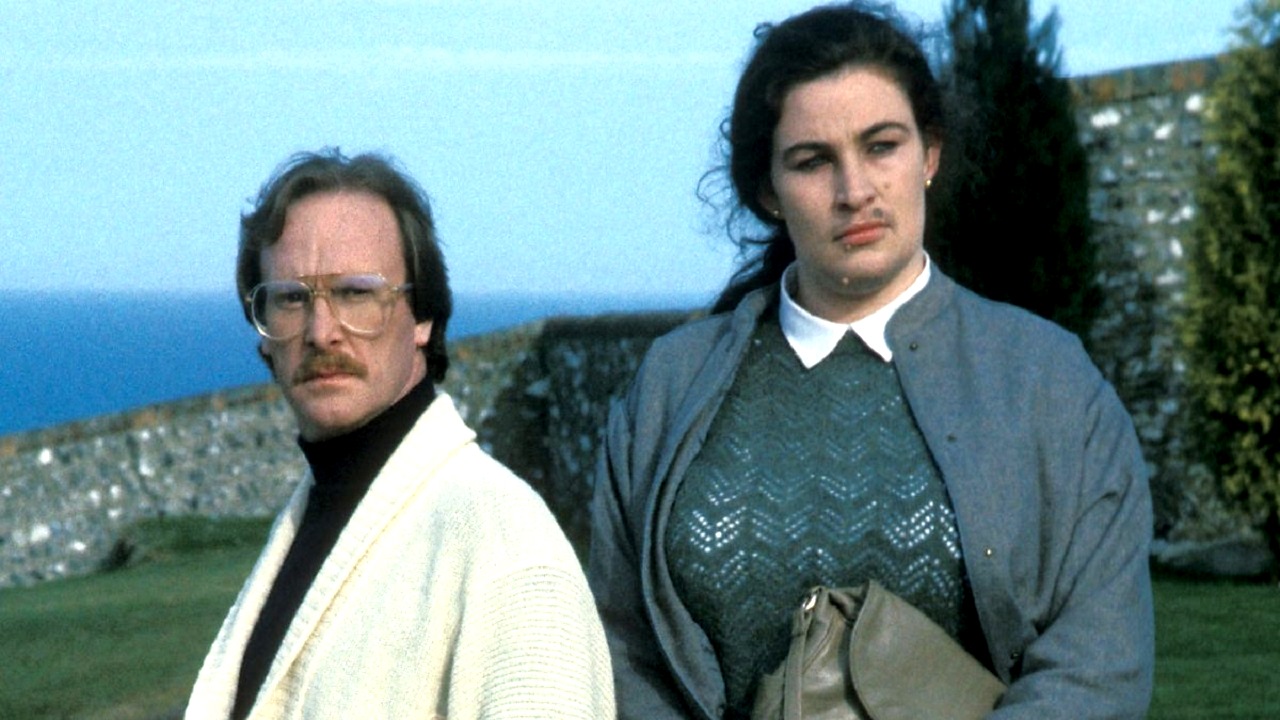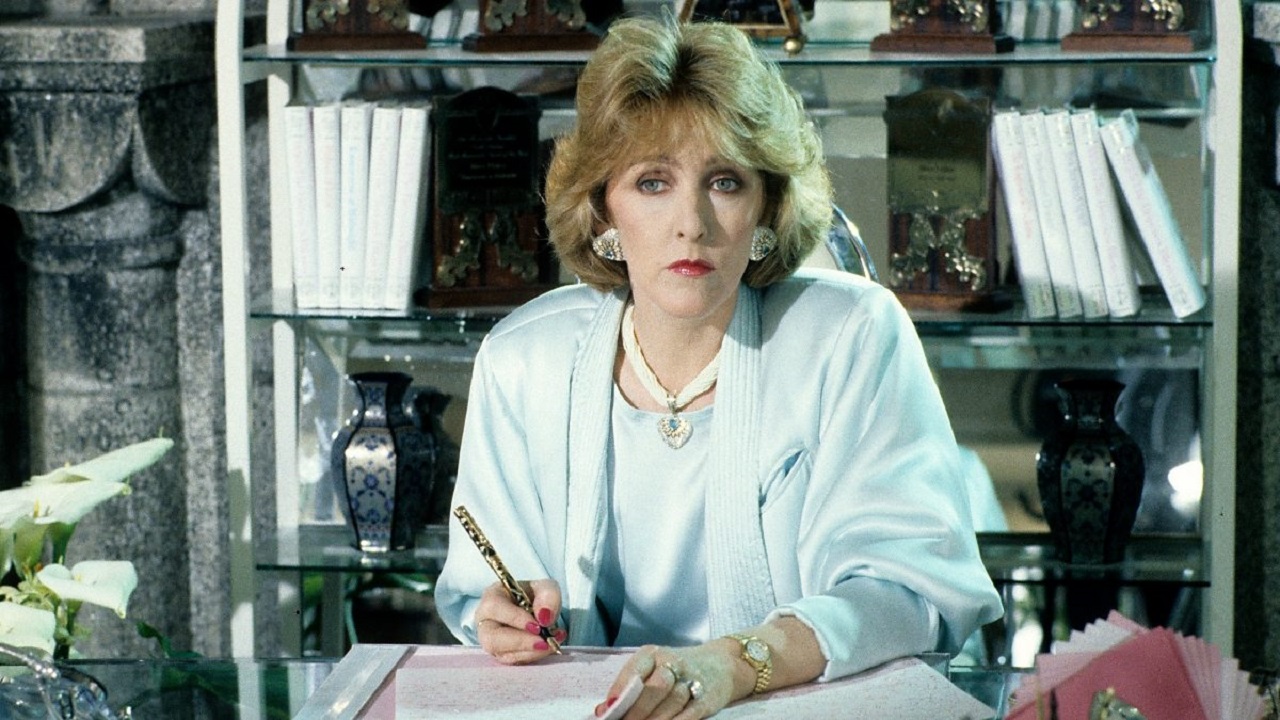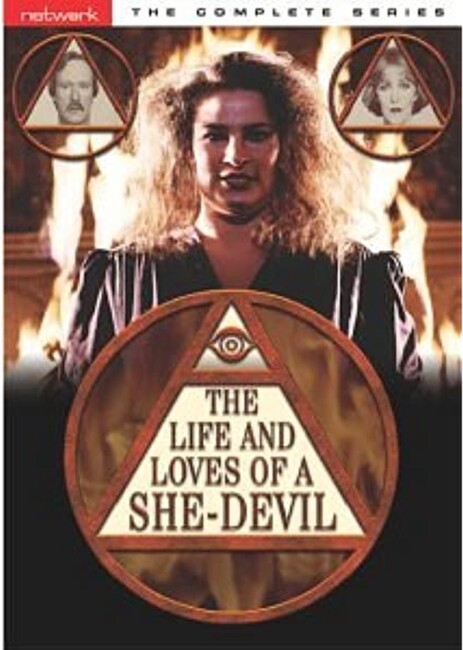UK/Australia. 1986.
Crew
Director – Philip Saville, Teleplay – Ted Whitehead, Based on the Novel The Life and Loves of a She-Devil (1983) by Fay Weldon, Producer – Sally Head, Music – Peter Filleul, Video Effects – Dave Jervis, Visual Effects Design – John Brace, Makeup Design – Elizabeth Rowell, Designer – Humphrey Jaeger. Production Company – BBC-tv/Arts and Entertainment Network/Seven Australia.
Cast
Julie T. Wallace (Ruth Beaswell), Dennis Waterman (Robert ‘Bobbo’ Beaswell), Patricia Hodge (Mary Fisher), Liz Smith (Mrs Fisher), Paul Herzberg (Garcia), Tom Baker (Father Ferguson), Miriam Margolyes (Nurse Hopkins), Bernard Hepton (Judge Bissop), Caroline Butler (Nicola Beaswell), Christopher Mossford (Andy Beaswell), John Bluthal (Angus Beaswell), Noel Dyson (Brenda Beaswell), Malcolm Terris (Geoffrey Tupton), Kim Thomson (Elsie Flowers), Ina Clough (Mrs Trumper), John Rowe (Dr Rohn), Stephen Grief (Dr Ghengis), Terrance Conder (Dr Black)
Plot
Ruth is married to accountant Robert ‘Bobbo’ Beaswell and they have two children. She is big-bodied, has a mustache and a mole on her lip, while Bobbo regards her as stupid. After meeting highly successful romance novelist Mary Fisher at a party, Bobbo takes over her accounts. The two then begin an affair and Bobbo announces to Ruth that he is in love with Mary. He moves in with Mary at her home in her converted cliffside lighthouse. Ruth responds by setting fire to the house and then dumping the two children with Bobbo. She then sets out to take revenge against Mary Fisher. First, she adopts a disguise and gets a job at the geriatric home where Mary’s mother lives, feeds her vitamins instead of tranquilisers and fakes bedwetting so that the mother is thrown out and forced to move in with Mary. Ruth and a fellow nurse then break in to Bobbo’s office and alter the books to steal a great deal of money. With this, they set up Vista Rose, a temp agency for women. From this, Ruth sends two girls to work for Bobbo, one to tempt him into having an affair, the other to hack his computer. Bobbo is arrested for fraud. Ruth adopts another disguise as nanny to the judge who has a penchant for S&M and contrives to manipulate him to send Bobbo to jail for seven years. She then sets out to ruin Mary and the notion of love she lived by.
Fay Weldon (1931-2023) was a British author who produced over thirty novels since her first appearance with The Fat Woman’s Joke (1967). Much of Weldon’s work circles around issues of feminism and women’s relationships with men. In a number of works, she has dabbled with science-fictional and fantastic elements. Following this adaptation of The Life and Loves of a She-Devil (1983), Weldon’s body of novels gained a prominence and there were adaptations of various of her other works, including the genre likes of the tv mini-series’ Growing Rich (1992) about three women who make pacts with a mysterious Devil figure and The Cloning of Joanna May (1991) about a woman who discovers her ex-husband has cloned her three times over, as well as the Nicolas Roeg film Puffball (2007) about rural witchcraft and pregnancy.
The Life and Loves of a She-Devil was a TV Mini-Series adaptation of Weldon’s book made for the BBC in four one-hour segments. It was considerably acclaimed when it came out, winning that year’s BAFTA for Best Dramatic Series and Julie T. Wallace being nominated for Best Actress. It was later remade in the US, effectively gutted of all its inflammatory feminism and turned into a clumsy comedy as She-Devil (1989) with Rosanne Barr as Ruth and Meryl Streep as Mary Fisher. Weldon later produced a sequel to the original book with The Death of a She-Devil (2017).
All of Fay Weldon’s works concern themselves with the role of women in society, in particular those caught in repressive relationships and situations. The Life and Loves of a She-Devil is about a jilted housewife taking revenge on her husband and his mistress. Weldon has an axe to grind and is unapologetic, indeed quite gleeful about it. The dialogue she delivers is gloriously barbed and sardonic with Julie T. Wallace delivering incredibly proclamatory lines such as “Mary Fisher created a dream of love. But I let in reality. And love cannot survive reality”, “Love robs a woman of her identity, her self” and “We shall start an agency. We shall liberate women whose talents have been spent on men, children and domesticity. We shall liberate them from love.”

You get the impression in all of this that Fay Weldon has a personal axe to grind – at the time she wrote the book, Weldon was on her second husband (and he left her a few years supposedly because his astrologer told him that their signs were incompatible!). All of this is fairly radical stuff, not to mention that the mini-series also pushes a blasphemous envelope and has Julie T. Wallace seducing a Catholic priest (Tom Baker, no less than the fourth Doctor Who) and turning him into a lust-crazed maniac as part of her revenge plan.
At times, this verges on black comedy, such as the rather funny scene where Dennis Waterman’s parents come to visit only for Julie T. Wallace to find that dog hair has gotten into the soup and this to transform into a meltdown and unleashing of her anger against him. The story frequently stretches credibility to near snapping point – if Ruth is using a shared chequing account to embezzle from Bobbo then would this not be one of the first avenues that any police investigation would check out? I keep forgetting that The Life and Loves of a She-Devil was made before the internet era where the paper trail that surrounds this was not as black-and-white, even so it does seem a stretch of the imagination. On the other hand, you could argue that Weldon is writing what is essentially a fantasy of feminine empowerment rather than a realist work.
You can compare The Life and Loves of a She-Devil to Fatal Attraction (1987), which came out not long after. Both are works that exist at almost entirely opposed ends of an extreme while covering very similar plot material. Fatal Attraction was an anti-feminist movie where Glenn Close is an unbalanced woman who takes vengeance on a married family man after he has a fling and abandons her; The Life and Loves of a She-Devil could almost be considered the mirror opposite where Julie T. Wallace is the abandoned wife who takes vengeance on her husband after he leaves her for another woman. The sympathies in Fatal Attraction are with Michael Douglas and he is easily forgiven for straying, whereas the sympathies here are entirely with Julie T. Wallace as the longsuffering wife.

If Fatal Attraction were rewritten from the same viewpoint as The Life and Loves of a She-Devil, Glenn Close would be the heroine and the bunny boiling scene and each of the nasty things she visits on Michael Douglas would be shown in terms of gleeful relish accompanied by a voiceover that philosophically explains how she is taking a stance against the way cowardly men treat women. Conversely, if The Life and Loves of a She-Devil were rewritten from the viewpoint of Fatal Attraction, Dennis Waterman would be the hero and Julie T. Wallace would be portrayed as a monstrously vengeful psychopath and her tricks of infiltrating various places, embezzling money, changing the grandmother’s meds, influencing the judge and so on would be seen as the kind of jolt twists you get in psycho-thrillers where you realise the fiendishness of the deranged antagonist, while she would undoubtedly be regarded as fully deservous of death at the end.
The Life and Loves of a She-Devil is largely a revenge story with a feminist manifesto. The fantastic element is slight or ambiguous at best. Ruth proclaims herself a ‘she-devil’ and we get images of her with glowing eyes and repeated shots of her nude body walking down a backlit hall overlaid or intercut with other shots where we seemingly see a supernatural wind blow from nowhere. This is most evident near the end when said winds appear to blow Patricia Hodge out the lighthouse window to her death. Even aside from that, Ruth seems capable of hatching diabolical revenge schemes that approach those of super-villains in their elaborate ingenuity.
The Life and Loves of a She-Devil brought to attention Julie T. Wallace, daughter of regular Hammer actor Andrew Keir. Wallace was an unknown at the time the mini-series was made, having only previously appeared in a guest role in one episode of a tv series. She uncannily taps the feeling of a frumpy unassertive housewife who is walked all over by her weak-willed husband. It becomes an extraordinary performance seeing her transform into the she-devil and become someone empowered and driven by an all-consuming sense of purpose. Not to mention that Wallace also gets to undergo several chameleon-like transformations into various disguises throughout the course of the show. Wallace has since gone onto various others roles and kept working, although mostly making tv guest appearances and nothing as high-profile as this. She can be spotted in small roles in the James Bond film The Living Daylights (1987), the Neil Gaiman tv series Neverwhere (1996) and the Wachowskis’ Speed Racer (2008), among others.
Director Philip Saville (1927-2016) has a career in British television that goes back to the 1960s, his most famous work being the hit mini-series The Boys from the Blackstuff (1982). Saville has made a number of other genre tv mini-series, including Count Dracula (1977), the BBC adaptation of Bram Stoker starring Louis Jourdan; the genetically engineered ape-human hybrid mini-series First Born (1988); a further Fay Weldon adaptation The Cloning of Joanna May (1991); and the Hallmark biopic My Life as a Fairytale: Hans Christian Andersen (2001). Saville rarely ventured into film and the occasions he did were little seen, including the strange Shadey (1985) about a man with psychic powers; The Fruit Machine (1988) about gay youths pursued by a killer; and the drama Metroland (1997).
Mini-series online in several parts beginning here


